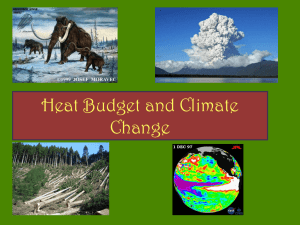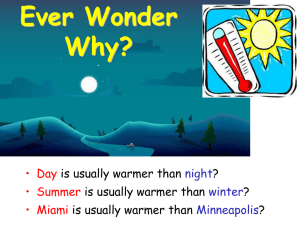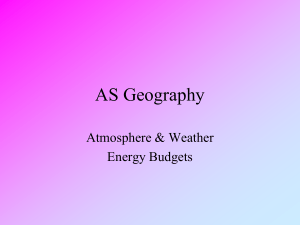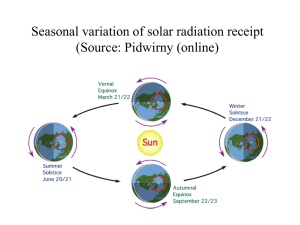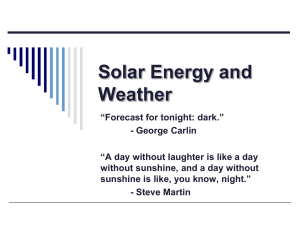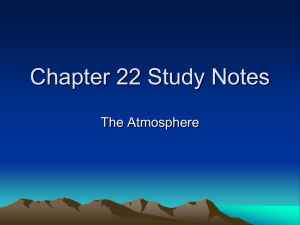Insolation and Temperature
advertisement
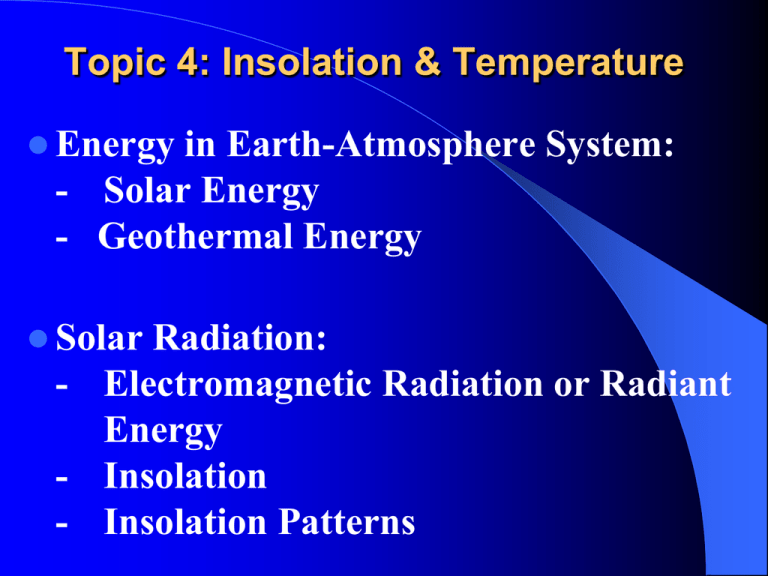
Topic 4: Insolation & Temperature Energy in Earth-Atmosphere System: - Solar Energy - Geothermal Energy Solar Radiation: - Electromagnetic Radiation or Radiant Energy - Insolation - Insolation Patterns Topic 4: Insolation & Temperature - Insolation Patterns => Daily Insolation patterns => Annual Insolation Patterns => Global Insolation Patterns The Heating of the Earth-Atmosphere System - Heating and Cooling Processes in the Atmosphere Topic 4: Insolation & Temperature The Heating of the Earth-Atmosphere System - Heating and Cooling Processes: => Radiation, Absorption => Reflection, Scattering => Transmission, Conduction => Convection, Advection => Adiabatic Cooling & Warming => Latent Heat Topic 4: Insolation & Temperature The Heating of the Earth-Atmosphere System - Atmospheric Energy Budget - Latitudinal Radiation Balance - Land and Water Contrasts Mechanisms of Heat Transfer: - Atmospheric Circulation - Oceanic Circulation Topic 4: Insolation & Temperature Air Temperature Patterns: - Vertical Air Temperature Patterns: => Lapse Rates => Temperature Inversions - Daily & Annual Cycles of Air Temperatures - Global Pattern of Air Temperature Factors in the Variation of Air Temperature Energy in Earth-Atmosphere System What is energy? Energy is what causes changes in the state or condition of matter: - what causes matter to move? - what causes matter to change direction? - what causes water to change from liquid to vapor? . Energy in Earth-Atmosphere System The ANSWER to those questions is ENERGY Many types of energy: - Kinetic Energy - Chemical Energy - Radiant Energy Energy cannot be created nor destroyed but can change from one form to another Energy in Earth-Atmosphere System Two major sources of energy in the earth-atmosphere system: - Solar Energy (99.97%) - Geothermal Energy (0.03%) Solar energy is produced in the sun by thermonuclear reactions (i.e., nuclear fusion of hydrogen to produce helium) Energy in Earth-Atmosphere System Geothermal energy comes from the interior of the earth and produced by radioactive minerals decay Energy from these sources: - supports life on earth and - drives all atmospheric and weather processes The Electromagnetic Radiation Radiant energy from the sun is transmitted through space in the form of electromagnetic waves No loss of energy as the waves travel through space Though its intensity continuously drops with increasing distance from the sun because ……. The Electromagnetic Radiation Because electromagnetic waves spread out as they travel further away from the sun, thereby losing its intensity Electromagnetic Waves The Electromagnetic Spectrum Electromagnetic waves are classified according to wavelengths and the electromagnetic spectrum contains various wavelengths Important groups of wavelengths are: - ultraviolet waves (0.01 – 0.4µm) - Visible Light (0.40 – 0.7 µm ) - infrared waves (0.70 - 1000 µm) The Electromagnetic Spectrum The Electromagnetic Spectrum According to Wien's displacement law, the wave length of maximum emission is inversely proportional to the absolute temperature of the radiating body Hence, the sun with a surface temperature of over 6000ºC (11,000ºF), propagates energy mainly in short waves (i.e., <4.0µm) * (a micron is one-millionth of a meter) Short Wavelengths of Solar Radiation The Electromagnetic Radiation In general, solar radiation comes mainly as: - shortwave radiation - visible light The Electromagnetic Radiation The total amount of energy produced by the sun may vary slightly due to: - changing distances of the sun from earth during the course of a year - 11 years sunspot cycles The Electromagnetic Radiation however, the amount of solar energy in vertical sun's rays striking a unit area (cm2) of the outer surface of the earth's atmosphere is fairly constant and called the solar constant solar constant is 2gm calories per square centimeter per minute or (2gm/cm2/min) or (2 langleys/minute) The Electromagnetic Radiation Note: a 1gm cal/cm2 = 1 Langley or (1gm/cm2 = 1ly) gram calorie is the quantity of heat energy required to raise by 1oC of temperature of 1 gm of pure water Solar Radiation: Insolation Insolation is the amount of solar energy intercepted by the earth's surface The actual amount received at the earth surface varies because of: - variations in the angle of incidence of the sun's rays - length of daylight and - insolation losses in the atmosphere Solar Radiation: Insolation Solar energy amount and the angle of incidence of the sun's rays: - vertical sun's rays striking at 90o produce more intense solar radiation because: Energy is concentrated over small area Lower loss of energy in rays traveling short distance through the atmosphere Angle of Incidence of Sun’s Rays Solar Radiation: Insolation - oblique sun's rays striking at low angles < 90o produce less intense solar radiation because of: the spread of sun's energy over a relatively large area the longer travel distance of sun's rays through the atmosphere Atmospheric Obstruction of Sun’s Rays Solar Radiation: Insolation - the intensity or amount of sun's radiation per unit of surface area is affected by the angle of the sun's rays Daily Patterns of Insolation Insolation begins at sunrise & increases progressively to a peak at noon, and thereafter, decreases to zero at sunset Insolation is highest at noon when the sun (solar altitude) is highest in the sky Insolation is zero at sunrise or at sunset is when solar altitude lowest in the sky Daily Cycle of Insolation Annual and Global Patterns of Insolation Generally, insolation is highest in summer and lowest in the winter Intermediate values of insolation are recorded in the fall and spring The equator has insolation curve with 2 peaks recorded at each of the 2 equinoxes in March and September when solar altitude is highest Insolation at Different Latitudes in a Year Annual and Global Patterns of Insolation Also, the equator has insolation curves with 2 minimums recorded at each of the two solstices in June and December when solar altitude is lowest Insolation is highest in the tropics because solar altitude is very high and close to vertical all year round Annual and Global Patterns of Insolation Places within the tropics have insolation curves with 2 peaks recorded twice a year when the sun is directly overhead in their locations Places between the Tropic of Cancer and the North Pole or Tropic of Capricorn and the South Pole have insolation curves with a single peak recorded during their summer solstice Global Insolation Atmospheric Heating and Cooling Processes The heating and cooling processes in the Atmosphere include: => Radiation, Absorption => Reflection, Scattering => Transmission, Conduction => Convection, Advection => Adiabatic Cooling & Warming => Latent Heat Heating & Cooling Processes: Absorption What is Absorption? - it is the process of an object taking in the radiant energy striking it - it cause the temperature of the absorbing object to increase - good absorber include: rock, soil and dark-colored objects Heating & Cooling Processes: Absorption - black bodies like the sun and earth are both good radiators & absorbers - a total of 22% of solar radiation is absorbed in the atmosphere by clouds, water vapor and dust particles Heating & Cooling Processes: Reflection What is Reflection? - It is the ability of surfaces to return electromagnetic waves back to space - cloud, snow, and other surfaces with whitish colors are good reflectors - a total of 33% of incoming solar radiation is reflected back to space and unavailable to warm up the earthatmosphere system Insolation Losses in the Atmosphere Insolation Losses Percent Loss Cloud Reflection 21% Reflection Scattering and Diffused Losses Reflection 4% (Albedo) Earth Surface Reflection 8% Total Reflection Losses 33% Absorption Ozone Absorption 3% Losses Atmosphere Absorption 19% Total Absorption Losses 22% TOTAL INSOLATION LOSSES 33% + 22% = 55% Heating & Cooling Processes: Scattering What is Scattering? - It is the ability of particulates & gas molecules to deflect and re-direct light waves - Shorter waves, especially violet and blue lights, are more susceptible to scattering Heating & Cooling Processes: Scattering - light waves may be scattered back to space or re-directed through the atmosphere as diffused radiation - Rayleigh Scattering occurs when the size of the scattering gas molecule less than the wavelength of the incoming radiation and therefore causes violet to blue lights to be scattered to produce the blue sky Heating & Cooling Processes: Scattering - Mie Scattering occurs when the radii of the scattering particle is greater than the wavelength of the incoming radiation Atmospheric Heating and Cooling Processes: Absorption, Reflection & Scattering the amount of solar energy received per square centimeter per minute at the earth surface is usually less than the solar constant because of energy losses in the atmosphere through: - reflection - scattering - absorption The Fate of Solar Reflection Near or At Earth’s Surface Insolation Losses in the Atmosphere Insolation Losses Percent Loss Cloud Reflection 21% Reflection Scattering and Diffused Losses Reflection 4% (Albedo) Earth Surface Reflection 8% Total Reflection Losses 33% Absorption Ozone Absorption 3% Losses Atmosphere Absorption 19% Total Absorption Losses 22% TOTAL INSOLATION LOSSES 33% + 22% = 55% Solar Radiation Losses in the Atmosphere Heating & Cooling Processes: Conduction What is Conduction? - it is a molecule to molecule flow of heat energy of a stationary body from its warmer molecules to the cooler molecules - this is how ground surface heat is transferred to the lower atmosphere by conduction Heating & Cooling Processes: Conduction - But both earth surface materials and the air are poor heat conductors - Hence, the physical movement of air from the earth surface to spread heat energy to the lower atmosphere is predominantly by convection and advection Heating & Cooling Processes: Conduction As a result, atmosphere is heated mostly from below rather than from above Heating & Cooling Processes: Convection What is Convection? - It involves the vertical transfer of heat by a moving substance or body - For example, heated air molecules move vertically away to reach and warm up cooler molecules above - Convection causes warm air to rise Heating & Cooling Processes: Advection - when the convecting movement is horizontal, it is called advection - Heat is advected from warm tropical areas toward the poles when warm winds or warm ocean currents move poleward Heating & Cooling Processes: Adiabatic Cooling and Warming Temperature of ascending or descending parcel of air in the atmosphere changes by: - Adiabatic cooling - Adiabatic warming Adiabatic cooling involves cooling by expansion of rising air parcel Heating & Cooling Processes: Adiabatic Cooling and Warming Adiabatic warming involves warming by compression of descending air parcel The Heating of the Atmosphere Solar energy received by the earth surface is utilized to warm up the earthatmosphere system through: - Latent heat (50%) - Longwave (infrared) energy (38%) - Sensible heat (12%) Longwave Radiation: - 38% of solar energy reaching the earth surface is converted into longwave energy Solar Radiation Redirected to the Atmosphere The Heating of the Atmosphere - earth re-radiates longwave energy in wavelengths between 5 & 30 microns or micrometer back to the atmosphere - While the atmosphere is transparent to shortwave solar radiation, much of longwave earth radiation is blocked or absorbed in the atmosphere The Heating of the Atmosphere - The blockage causes the atmosphere to heat up, a phenomenon called greenhouse effect - Water vapor, carbon dioxide, ozone & methane are greenhouse gases because they allow the passage of shortwave solar energy but absorbs outgoing longwave radiation The Heating of the Atmosphere Latent Heat Energy: - 50% of solar energy reaching earth surface is converted into latent heat - It is energy stored in water and water vapor - It is hidden and cannot be felt The Heating of the Atmosphere - Water changes to vapor by absorbing heat energy (latent heat of vaporization) from its surrounding and causing a cooling effect - Latent heat is carried into the atmosphere by rise air - Hence, it is important in heat exchange between the earth surface and the atmosphere The Heating of the Atmosphere - Latent heat is converted into sensible when vapor changes back to liquid condensation) in upper atmosphere - It is a great conveyor belt of heat energy between the earth and the atmosphere driven by convection The Heating of the Atmosphere Sensible Heat: - 12% of solar energy is converted into sensible heat - it is detectable by human sense of touch and measurable with the thermometer - it reaches the lower atmosphere from the earth surface through conduction, convection or advection The Heating of the Atmosphere As a result, atmosphere is heated mostly from below rather than from above Some of the total energy gained by the atmosphere is re-radiated back to the earth surface in the form of COUNTERRADIATION The Heating of the Earth-Atmosphere System: Radiation Balance The amount of solar energy received by the earth surface is equal to the amount that the earth surface returns to the atmosphere in the form of longwave radiation, latent heat and sensible heat The difference between the amount of solar radiation received and outgoing radiation from the earth surface is called net radiation Simplified Energy Budget Detailed Energy Budget The Heating of the Earth-Atmosphere System: Radiation Balance On a global and annual basis, net radiation is zero Hence the global energy balance is zero However, there are places where net radiation is well above zero, especially within the tropics or well below zero, especially in the polar regions Net Radiation: Energy Surplus and Deficit Areas The Heating of the Earth-Atmosphere System: Radiation Balance In general, there is a significant energy surplus in the region between lat 40oN and 38oS and a significant energy deficit in the polar regions outside the region of surplus The Heating of the Earth-Atmosphere System: Radiation Balance This general global imbalance in energy distribution is ameliorated by the redistribution of heat by atmospheric and oceanic circulations The Heating of the Earth-Atmosphere System: Radiation Balance The air temperature of a place is closely related to its net radiation distribution On a daily basis, temperature increases progressively during the day as net radiation increases and drops throughout the night as net radiation drops Daily Cycles of Insolation, Net Radiation & Temperature Daily Cycle of Insolation Daily Cycle of Net Radiation Daily Cycle of Air Temperature The Heating of the Earth-Atmosphere System: Radiation Balance On an annual basis, temperature is high in summer in most places because of the high net radiation recorded during that season and vice versa during the winter Generally, the peak of air temperature often lags behind the peak of insolation or net radiation because of the extra time required to warm up the earthatmosphere system Annual Cycles of Net Radiation in Relation to Air Temperature Annual Cycles of Net Radiation in Relation to Air Temperature Air Temperature Air temperature is measured with a thermometer in degrees Celsius (ºC) or Fahrenheit (ºF) From Celsius (C) to Fahrenheit (F) use: oF = 9/5C + 32o From Fahrenheit (F) to Celsius (C) use: oC = 5/9(F-32o) Air Temperature Mercury-filled thermometers are commonly used to measure temperature Digital thermometer equipped with thermistor are increasing being used today There are over 5000 weather stations in the U.S. where air temperature is measured Air Temperature Most weather stations report the highest and lowest temperature recorded during a 24-hr period using the maximumminimum thermometers The thermometers are often housed in a white wooden box shelter called the Stevenson screen Stevenson Screen: Thermometer Shelter Vertical Air Temperature Profile Temperature varies both horizontally and vertically Vertical temperature patterns also have direct influence on climatic processes Under normal conditions, temperature decreases with increasing altitude within the troposphere Vertical Air Temperature Profile This is commonly referred to as the normal lapse rate condition normal lapse rate is 3.6oF per 1000 ft (or 6.5oF per kilometer or 1000 meters) The This rate is not always constant Normal Topospheric Lapse Rate Vertical Air Temperature Profile In the lower part of the troposphere, temperature may increase upward for a limited distance according to: - season - time of day - amount of cloud cover Such reversal of the normal lapse-rate condition is called temperature inversion Temperature Inversion in Lower Atmosphere Vertical Air Temperature Profile: Temperature Inversion It’s a condition where temperature increases with increasing altitude in the troposphere It’s duration is usually short and restricted in depth Occurs near the Earth’s surface as well as in the upper levels Vertical Air Temperature Profile: Temperature Inversion Climatic Effects of Temperature Inversion: - inhibition of vertical air movements and a general stagnation of the air - inhibition of precipitation formation process - increased air pollution (no upward dispersal of pollutants) Vertical Air Temperature Profile: Temperature Inversion There are two broad types of inversion: surface and upper air inversions Surface air inversion consists of three types based on how they are formed: - Radiational Inversions - Advectional Inversion - Cold Air Drainage Inversion: Vertical Air Temperature Profile: Temperature Inversion Radiational Inversion: - occurs at night when the sky is blue & calm, especially during the cold winter seasons - and surface cools rapidly due to rapid long-wave radiation loss - causes ground surface to be colder than the air above Vertical Air Temperature Profile: Temperature Inversion - Cold ground surface cools the air above by conduction - Hence, the lowest few hundred feet of the troposphere become colder than the air above - common in temperate latitudes Vertical Air Temperature Profile: Temperature Inversion Advectional Inversions: - caused by the horizontal inflow of cold air into an area - common in coastal areas with onshore cool maritime air flow - inversion is shallow and short in duration & may occur anytime of the year Vertical Air Temperature Profile: Temperature Inversion Cold Air-Drainage Inversions: - caused by cooler air sliding down the hill slope into the valley - descending air displaces the warmer air to cause an inversion - common in winter Vertical Air Temperature Profile: Temperature Inversion Upper Air Inversion: - occurs in the upper levels with a base of a few thousand feet above ground - common in winter in areas with high pressure conditions like the subtropical high pressure belt - caused by air sinking from above Temperature Inversion in Upper Atmosphere Daily Cycle of Air Temperature Daily cycle of temperature is controlled by the daily cycle of net radiation Daily minimum air temperature occurs just before sunrise it attains a maximum at between 2 and 4 P.M. and drops throughout the night Daily Cycles of Insolation, Net Radiation & Temperature Daily Cycle of Air Temperature Insolation begins at sunrise, attains a maximum at noon and ends at sunset Similarly, net radiation is positive shortly after sunrise, attains a maximum at noon and reaches zero at sunset When net radiation is positive, surface gains heat and loses heat when negative Annual Cycle of Air Temperature The annual cycle of net radiation drives the annual cycle of air temperature Temperatures in equatorial regions change very little throughout the year is uniformly high (81oF) with a small rise in temperature shortly after the equinoxes Temperature Annual Cycles of Net Radiation in Relation to Air Temperature Annual Cycle of Air Temperature Within the tropics, net radiation surplus is large all year Peak temperature occurs during or shortly after the summer solstice and lowest in winter solstice in the tropics In the mid-latitudes, surplus net radiation occurs 9 months with deficit in winter Annual Cycle of Air Temperature Air temperature shows similar patterns with high temperature range of >30oF in the mid-latitudes In the poles, we have: - 6 months deficit net radiation - 6 months surplus, hence: - an extremely low winter temperature of about -50oF and a summer peak of about 55oF Annual Cycle of Air Temperature - and an extremely large temperature range of of up to (110oF) In general, monthly temperature maximums and minimums occur later at coastal stations than at interior stations Hence, the hottest month of the year for interior regions is July but in August at coastal locations (N.H.) Annual Cycle of Air Temperature The coldest month for large interior land areas is in January but in February at coastal locations (N.H.) The reason for the timing difference is the fact that oceans heat and cool more slowly than continents Global Patterns of Air Temperature Air temperatures decrease from the equator to the poles and confirmed by - the east-west trends in isotherms from the equator to the mid-latitudes, and - the circular isotherms in the polar regions Large landmasses located in the subarctic and arctic zones develop centers of extremely low temperature Average July Temperature Pattern Average July Sea-Level Temperatures January Temperature Pattern Average January Sea-Level Temperatures Global Patterns of Air Temperature Centers of low winter temperatures: - North America (northern Canada, -35oC or –32oF) - Interior Asia (Siberia, -50oC or -58oF) - Antarctica and Greenland Temperatures in equatorial regions change little throughout the year Global Patterns of Air Temperature Isotherms make a large north-south shift from winter to summer over continents in the mid-latitude and subarctic zones Highlands are always colder than surrounding lowlands Areas of perpetual ice and snow are always intensely cold Global Patterns of Air Temperature Global pattern of annual temperature range: - Annual range increases with latitude, especially over northern hemisphere continents - The greatest ranges occur in the subarctic and arctic zones of Asia and North America Average Annual Temperature Range Global Patterns of Air Temperature - The annual range is moderately large on land areas in the tropical zone, near the tropics of Cancer and Capricorn - The annual range over oceans is less than that over land at the same latitude - The annual range is very small over oceans in the tropical zone Global Patterns of Air Temperature Global air temperature patterns are controlled primarily by: - Latitude Maritime Effects Continentality Effects Elevation Review Questions for Topic 4 1) In the first 11 miles above Earth’s surface, air temperature generally ___________ with increasing elevation. A. increases B. decreases C. stabilizes D. reaches equilibrium E. rises 1) In the first 11 miles above Earth’s surface, air temperature generally ___________ with increasing elevation. A. increases B. decreases C. stabilizes D. reaches equilibrium E. rises Figure 4-27a Explanation: The observed vertical change in temperature in the troposphere is decreasing with height. 2) The west wind drift forms as a result of A. decreased Coriolis near the equator. B. global warming. C. the Arctic Ocean. D. fewer landmasses near the poles of the Northern Hemisphere. E. fewer landmasses near the poles of the Southern Hemisphere. Figure 4-25 2) The west wind drift forms as a result of A. decreased Coriolis near the equator. B. global warming. C. the Arctic Ocean. D. fewer landmasses near the poles of the Northern Hemisphere. Figure 4-25 E. fewer landmasses near the poles of the Southern Hemisphere. Explanation: In the Southern Hemisphere, fewer landmasses allow for a constant westward flow of ocean water near the South Pole, 3) Even though no heat is taken in from an external source, adiabatic warming involves warming by compression in __________ air. A. sinking B. rising C. immobile D. ascending E. confused 3) Even though no heat is taken in from an external source, adiabatic warming involves warming by compression in __________ air. A. sinking B. rising C. immobile D. ascending E. confused Explanation: When air sinks, the air molecules become closer together, and their collisions increase. As the collisions increase, kinetic energy and temperature increase. 4) ________ heat is required when water is converted into ice. A. Latent heat of freezing B. Sensible heat of freezing C. Latent heat of melting D. Latent heat of condensation E. Latent heat of vaporization 4) ________ heat is required when water is converted into ice. A. Latent heat of freezing B. Sensible heat of freezing C. Latent heat of melting D. Latent heat of condensation E. Latent heat of vaporization Explanation: When water is converted to ice, the process of freezing takes place. Extra heat release is required to freeze liquid water, called latent heat of freezing. 5) Incoming solar energy is redirected by particulate matter and gas molecules in the atmosphere, therefore lost to Earth through what process? A. Tropospheric repulsion B. Terrestrial emission C. Reflection D. Absorption E. Scattering 5) Incoming solar energy is redirected by particulate matter and gas molecules in the atmosphere, therefore lost to Earth through what process? A. Tropospheric repulsion B. Terrestrial emission C. Reflection D. Absorption E. Scattering Explanation: As radiation collides with particulate matter, it is evenly scattered in All directions away from the particle. Some of this scattered radiation is lost to space. 6) The main source of energy for Earth’s atmosphere is heat A. radiated by millions of other stars besides the sun. B. from solar insolation (Sun). C. generated by gigantic tidal waves. D. released as radioactive minerals decay at great depth. E. released on the ocean floor through hydrothermal vents. 6) The main source of energy for Earth’s atmosphere is heat A. radiated by millions of other stars besides the sun. B. from solar insolation (Sun). C. generated by gigantic tidal waves. D. released as radioactive minerals decay at great depth. E. released on the ocean floor through hydrothermal vents. Explanation: Incoming solar radiation accounts for a vast majority of all energy that Earth’s atmosphere acquires. Figure 4-17 7) The world’s largest annual temperature range typically occurs in the interior of what latitudes? A. Low B. High C. Middle D. Eastern E. Southern Figure 4-32 7) The world’s largest annual temperature range typically occurs in the interior of what latitudes? A. Low B. High C. Middle D. Eastern E. Southern Explanation: Interior high latitudes have the greatest variation in solar angle, and are not subject to the temperature constraints of a maritime climate. Thus, these are the regions of greatest annual temperature variation. 8) Which of these geographic regions would be characterized by a high albedo? A. The rain forests B. The oceans C. The Arctic D. The plains E. The Great Lakes Figure 4-G 8) Which of these geographic regions would be characterized by a high albedo? A. The rain forests B. The oceans C. The Arctic D. The plains E. The Great Lakes Explanation: Ice cover in the Arctic is white, which is a highly reflective surface. As a result, the albedo in the polar regions in both hemispheres is typically very high. 9) Which of the following could NOT be a cause for land warming faster than water? A. Water has lower sensible heat B. Water has higher sensible heat C. Water has more evaporative cooling D. Water is in constant motion E. Water has limited transmission Figure 4-23 9) Which of the following could NOT be a cause for land warming faster than water? A. Water has lower sensible heat B. Water has higher sensible heat C. Water has more evaporative cooling D. Water is in constant motion E. Water has limited transmission Explanation: The higher sensible heat value for water allows it to absorb more heat before its temperature rises. If water had a lower sensible heat than land, its temperature would rise more quickly than land’s temperature! 10) Which phrase best describes global warming? A. Global carbon dioxide levels are sinking B. Global temperatures are cooling C. Ocean temperatures are warming D. Earth’s core is warming Figure 4-35 E. The greenhouse effect is increasing 10) Which phrase best describes global warming? A. Global carbon dioxide levels are sinking B. Global temperatures are cooling C. Ocean temperatures are warming D. Earth’s core is warming Figure 4-35 E. The greenhouse effect is increasing Explanation: Increased carbon dioxide is contributing to an enhanced greenhouse effect, which in turn is increasing global temperatures. This process is called global warming. Review Questions for Topic 3 1) The main surface currents in the major ocean basins assist in the heat transfer around the world by moving A. warm water from the Northern Hemisphere to the Southern Hemisphere. B. cool water from the poles to the tropics. C. warm water from the poles to the tropics. D. cool water from the tropics to the poles. E. warm water from the Southern Hemisphere to the Northern Hemisphere. Figure 3-18 1) The main surface currents in the major ocean basins assist in the heat transfer around the world by moving A. warm water from the Northern Hemisphere to the Southern Hemisphere. B. cool water from the poles to the tropics. C. warm water from the poles to the tropics. D. cool water from the tropics to the poles. Figure 3-18 E. warm water from the Southern Hemisphere to the Northern Hemisphere. Explanation: Northerly ocean currents from the poles to the tropics transport cooler water from higher latitudes to lower latitudes. 2) An example of climate (versus weather) for a given area is A. the air temperature reached 78°F today. B. rain showers are predicted for next Saturday. C. the record high temperature is 122°F. D. the average rainfall in April is 15 inches. E. thunderstorms occurred last Mother’s day. 2) An example of climate (versus weather) for a given area is A. the air temperature reached 78°F today. B. rain showers are predicted for next Saturday. C. the record high temperature is 122°F. D. the average rainfall in April is 15 inches. E. thunderstorms occurred last Mother’s day. Explanation: Climate describes weather conditions over a long period. So, an average weather condition over a span of many months would be a climate condition 3) Temperature decreases with increasing elevation in which thermal atmospheric layers? A. Troposphere and stratosphere B. Thermosphere and mesosphere C. Troposphere and mesosphere D. Troposphere only E. Stratosphere and thermosphere 3) Temperature decreases with increasing elevation in which thermal atmospheric layers? A. Troposphere and stratosphere B. Thermosphere and mesosphere C. Troposphere and mesosphere D. Troposphere only E. Stratosphere and thermosphere Explanation: In Figure 3-5, we see that temperature values decrease as you ascend in the image. Through the remaining layers, temperature increases with height. 4) _______ is the most plentiful variable gas in the atmosphere. However, it varies in location, not in time. A. Nitrogen B. Ozone C. Carbon dioxide D. Oxygen E. Water vapor 4) _______ is the most plentiful variable gas in the atmosphere. However, it varies in location, not in time. A. Nitrogen B. Ozone C. Carbon dioxide D. Oxygen E. Water vapor Explanation: Water vapor in the atmosphere is highly variable, falling out as precipitation and being replenished by water sources. Its composition can vary from 0-4% of the total atmosphere. 5) Oxygen accounts for what proportion of the of the volume of gases in the atmosphere? A. 21% B. 78% C. 0.037% D. 1-4% E. 0.9% Figure 3-1 5) Oxygen accounts for what proportion of the of the volume of gases in the atmosphere? A. 21% B. 78% C. 0.037% D. 1-4% E. 0.9% Explanation: While oxygen is the most important element for life, it makes up a relatively small percentage of the atmosphere when compared to nitrogen. 6) If a wind of 55 mph were subjected to a Coriolis force that is double what exists on Earth, what would its new speed be? A. 110 mph B. 27.5 mph C. 45 mph D. 0 mph E. 55 mph Figure 3-22 6) If a wind of 55 mph were subjected to a Coriolis force that is double what exists on Earth, what would its new speed be? A. 110 mph B. 27.5 mph C. 45 mph D. 0 mph E. 55 mph Explanation: The Coriolis force affects the direction of motion, but not the speed. Doubling the Coriolis force will not affect the speed of the wind. 7) The aurora borealis typically occurs in A. the homosphere. B. the troposphere. C. the ionosphere. D. the stratosphere. E. the mesosphere. Figure 3-10 7) The aurora borealis typically occurs in A. the homosphere. B. the troposphere. C. the ionosphere. D. the stratosphere. E. the mesosphere. Figure 3-10 Explanation: In the ionosphere, charged particles interacting with ultraviolet solar Radiation cause these particles to glow, forming the aurora phenomena. 8) Which of the following is an example of a secondary pollutant? A. Carbon monoxide B. Carbon dioxide C. Particulates D. Smog E. CFCs 8) Which of the following is an example of a secondary pollutant? A. Carbon monoxide B. Carbon dioxide C. Particulates D. Smog E. CFCs Explanation: Secondary pollutants form as a result of a process from a primary pollutant. Smog forms when smoke mixes with fog, so it is a secondary pollutant. 9) Ozone is depleted by CFCs. What is the primary atom in the CFC molecule that is responsible for ozone depletion? A. Oxygen B. Fluoride C. Fluorine D. Chloride E. Chlorine 9) Ozone is depleted by CFCs. What is the primary atom in the CFC molecule that is responsible for ozone depletion? A. Oxygen B. Fluoride C. Fluorine D. Cchloride E. Chlorine Explanation: The chlorine atom in a CFC molecule attracts oxygen atoms from ozone, causing the ozone molecule to break into a regular oxygen molecule, resulting in ozone depletion. 10) Los Angeles, California and Dallas, Texas have vastly different climates, despite existing at the same latitude. What causes the climate difference? A. Proximity to a desert B. Sun is more directly overhead in Dallas C. Los Angeles is near mountains D. Dallas is in the Plains E. Dallas is continental; Los Angeles is maritime. 10) Los Angeles, California and Dallas, Texas have vastly different climates, despite existing at the same latitude. What causes the climate difference? A. Proximity to a desert B. Sun is more directly overhead in Dallas C. Los Angeles is near mountains D. Dallas is in the Plains E. Dallas is continental; Los Angeles is maritime. Explanation: LA’s proximity to water allows for a less variable climate in terms of temperature. In general, maritime regions have a less volatile climate than continental regions.



